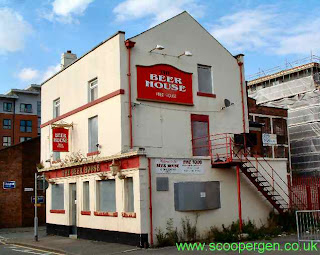Friday, 30 April 2010
Cronshaws Brewery, Erskine Street, Hulme
Thursday, 29 April 2010
St Peter's Hotel, Booth Street
Hardy's Crown Brewery, Renshaw Street, Hulme
Tuesday, 27 April 2010
Berlin / Asylum, King Street West

Rafters / Jilly's / Music Box, Oxford Street

Cloisters, Oxford Street
Legend / 5th Avenue, Princess Street

Rotters, Oxford Street

Rotters, Oxford Street, 1980s. (c) stagedoor at flickr.
Thankfully, the Wurlitzer organ on display in the Gaumont Theatre is still in use today at Folly Farm in South Wales, having been previously in display at the Granada Studios Tours (closed) then owned by the Lancastrian Theatre Organ Trust [2].
Monday, 26 April 2010
Kays Atlas Brewery, Grey Street, Ardwick



Kays Atlas bottle. (c) BruceMobley.com.
Sunday, 25 April 2010
Free Trade Hall, Peter Street

Free Trade Hall, Peter Street. (c) www.aidan.co.uk.
Built in 1853-1856 to the designs of Edward Walters, near the site of the 1819 Peterloo Massacre on what is today Peter Street (formerly St. Peters Fields), the Free Trade Hall was a symbol of free trade and the wealth that it helped to generate for Manchester during the Industrial Revolution. It was also used as a concert hall, the Hallé Orchestra first performing there in 1858, and continuing to do so until its move in 1996 to the Bridgewater Hall.
Free Trade Hall. (c) old-print.com.
There have, in fact, been three buildings known as the Free Trade Hall on the same site. The first two were built to host meetings of the Anti-Corn Law League, during the Corn Law debates of the 1830s and 1840s. The first building was a wooden structure, followed by a more solid stone construction. The third, the facade of which still stands today, was completed in 1856, as a permanent monument to commemorate the repeal of the Corn Laws ten years previously. Heavy bombing during the Manchester Blitz severely damaged the building, and it was reconstructed by Leonard Howitt, eventually re-opening as a concert hall in 1951.
Free Trade Hall, WWII. (c) BBC.
In 1997, the building was sold by the council to private developers and the reconstructed building retains the original facade but has been otherwise completely rebuilt as the Radisson Edwardian Hotel [1]. Two of the most famous concerts in musical history took place at the Free Trade Hall - Bob Dylan's "electric gig" on 17th May 1966, where he was famously branded a Judas by a member of the audience for deserting his folk roots; and the Sex Pistol's on 4th July 1976, upstairs at the Lesser Free Trade Hall, organised by the Buzzcocks and attended by what were to become Joy Division, The Smiths and The Fall. Like all good gig venues it had a bar of sorts. These 1955 photos show the bar in the public Promenade Lounge.
Metro Bar & Restaurant, St Peter's Square
Thursday, 22 April 2010
Ducie Arms Hotel, New Bridge Street
Waterloo Hotel, Chatham Street
Spread Eagle, Hanging Ditch
Wednesday, 21 April 2010
Concert Tavern, York Street
Old Swan, Long Millgate
Mosley Arms Hotel, Piccadilly
Monday, 19 April 2010
065. Yates's, Portland Street

064. Ducie Bridge, Corporation Street

063. Angel / Beer House / Weavers Arms, Angel Street













































